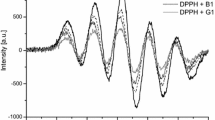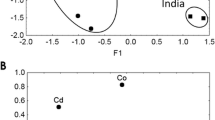Abstract
Qualitative and quantitative analyses of nutritional supplements and adulteration/toxic elements present in various tea leaves have been performed and compared. Rapid identification of inorganic (i.e., Ca, K, Na, Mg, Ba, Al, Sr, Mn) and organic (C, N, O, H) elements have been done using laser-induced breakdown (LIB) spectra of tea leaves. The electronic bands of the metal oxides (CaO, BaO, SrO, and AlO) are also identified. Molecular bands of CN and C2 molecules in the LIB spectra show the presence of organic compounds in the tea samples. The concentration of the constituents of the tea samples has been determined using the calibration free (CF-LIBS) technique and results are further compared with results obtained by energy-dispersive X-ray (EDX) technique. The toxicity of the various tea leaves has been discussed based on the contents of Ba, Al, and Sr in each sample. The quantitative analysis of Na, K, and Mg may be helpful to control hypertension and chronic kidney disease. Principal component analysis (PCA) classifies the different samples based on their elemental constituents. In all tea leaves samples, the presence of amino acids, enzymes, pigments, carbohydrates, caffeine and nicotine has been established via photoacoustic spectroscopy (PAS). Further, the confirmation of the molecular bands of the tea leaves is done with (Fourier Transform Infrared) FTIR spectroscopic technique.






Similar content being viewed by others
Data Availability
Not Applicable.
Code Availability
Not Applicable.
References
Mondal TK, Bhattacharya A, Laxmikumaran M, Ahuja PS (2004) Recent advances of tea (Camellia Sinensis) biotechnology. Plant Cell Tissue Organ Cult 76:195–254
Banerjee B (1992) Botanical classification of tea. In: Willson KC, Clifford MN (eds) Tea: cultivation to consumption. Chapman & Hall, London
Gutman RS, Ryu BH (1997) Chemistry and applications of green tea. CRC Press, Boca Raton
Cabrera C, Artacho R, Giménez R (2006) Beneficial effects of green tea-a review. J Am Coll Nutr 25:79–99
Rogers PJ, Smith JE, Heatherley SV, Pleydell-Pearce CW (2008) Time for tea: mood, blood pressure and cognitive performance effects of caffeine and theanine administered alone and together. Psychopharmacology 195:569–577
Chacko SM, Thambi PT, Kuttan R (2010) Beneficial effects of green tea: A literature review. Chin Med. https://doi.org/10.1186/1749-8546-5-13
Shirakami Y, Shimizu M (2018) Possible mechanisms of green tea and its constituents against cancer. Molecules 23:9–2284. https://doi.org/10.3390/molecules23092284
Hosoda K, Wang MF, Liao ML, Chuang CK, Iha M, Clevidence B, Yamamoto S (2003) Antihyperglycemic effect of oolong tea in type 2 diabetes. Diabetes Care 26:1714–1718
Seenivasan S, Manikandan N, Muraleedharan NN, Selvasundaram R (2008) Heavy metal content of black teas from south india. Food Control 19:746–749
Jaishankar M, Tseten T, Anbalagan N, Mathew BB, Beeregowda KN (2014) Toxicity mechanism and health effects of some heavy metals. Interdiscip Toxicol 7:60–72
Welna M, Szymczycha-MadejaA PP (2020) Non-Chromatographic speciation of As by HG technique-analysis of samples with different matrices. Molecules 25:21–4944. https://doi.org/10.3390/molecules25214944
Wang XP, Ma YJ, Itoh M (2005) Analysis of 23 mineral elements in tea samples collected from China and Japan by using ICP-AES and ICP-MS combined with a closed decomposition. Guangpuxueyuguangpu fen xi=Guangpu 25:1703–1707
Agrawal R, Kumar R, Rai S (2011) LIBS: A quality control tool for food supplements. Food Biophys 6:527. https://doi.org/10.1007/s11483-011-9235-y
Rai PK, Jaiswal D, Rai NK (2009) New Strategies of LIBS-Based validation of glycemic elements for diabetes management. Food Biophy 4:260–265
Gazali Z, Kumar R, Rai PK, Rai PK, Rai AK, Thakur SN (2021) Discrimination of gallbladder stone employing laser-induced breakdown spectroscopy (libs) and photoacoustic spectroscopy (PAS). Spectrochim Acta A 260:119948. https://doi.org/10.1016/j.saa.2021.119948
NIST: National Institute of Standards and Technology USA, Electronic Database. Available online: http://physics.nist.gov/PhysRefData/ASD/linesform.html
Pearse RWB, Gydon AG (1951) The identification of molecular spectra, 1st edn. American Chemical Society, Washington, WA, USA
Singh VK, Rai NK, Pandhija S, Rai AK, Rai PK (2009) Investigation of common indian edible salts suitable for kidney disease by laser induced breakdown spectroscopy. Lasers Med Sci 24:917–924
Ginos BNR, Engberink RHGO (2020) Estimation of sodium and potassium intake: current limitations and future perspectives. Nutrients 12:11–3275. https://doi.org/10.3390/nu12113275
Ekinci EI, Cheong KY, Dobson M, Premaratne E, Finch S, Macisaac RJ, Jerums G (2010) High sodium and low potassium intake in patients with type 2 diabetes. Diabet Med 27:1401–1408
Mziolek AW, Palleschi V, Schechter I (2006) Laser induced breakdown spectroscopy (LIBS) fundamentals and applications. Cambridge University Press, New York
Kumar R, Rai AK, Alamelu D, Aggarwal SK (2013) Monitoring of toxic elements present in sludge of industrial waste using CF-LIBS. Environ Monit Assess 185:171–180
Krewski D, Yokel RA, Nieboer E, Borchelt D, Cohen J, Harry J, Kacew S, Lindsay J, Mahfouz AM, Rondeau V (2007) Human health risk assessment for aluminium, aluminium oxide, and aluminium hydroxide. J Toxicol Environ Health B Crit Rev 10:1–269
Peng H, Yao F, Xiong S, Wu Z, Niw G, Lu T (2021) Strontium in public drinking water and associated public health risks in Chinese cities. Environ Sci Pollut Res 28:23048–23059
Kowalczyk E, Givelet L, Amlund H, Sloth JJ, Hansen M (2022) Risk assessment of rare earth elements, antimony, barium, boron, lithium, tellurium, thallium and vanadium in teas. EFSA J. https://doi.org/10.2903/j.efsa.2022.e200410
Gazali Z, Thakur SN, Rai AK (2019) Compositional study of gallbladder stone using photoacoustic spectroscopy. Optic Las Techn 111:696–700
Hernández-Aguilar C, Domínguez-Pacheco A, Cruz-Orea A, Ivanov R (2019) Photoacoustic spectroscopy in the optical characterization of foodstuff: a review. J Spectro. https://doi.org/10.1155/2019/5920948
Kumari R, Kumar R, Rai AK (2021) Evaluation of Na and K in anti-diabetic ayurvedic medicine using LIBS. Lasers Med Sci 37:53–522. https://doi.org/10.1007/s10103-021-03289-y
Acknowledgements
Two authors Mr. Tejmani Kumar and Dr. Abhishek Dwivedi thank UGC, New Delhi for CRET and Dr. D. S. Kothari fellowships as financial support.
Funding
Not Applicable.
Author information
Authors and Affiliations
Contributions
TK: Conceptualization, Investigation and Writing-Original draft, AKR: Resources, Writing—Review & Editing, AD: Writing-Review & Editing, RK: Validation, Formal analysis, AKR: Supervisor, Resources, Writing—Review & Editing.
Corresponding author
Ethics declarations
Conflict of interest
The authors declare that they have no known competing financial interests or personal relationships that could have appeared to influence the work reported in this paper.
Ethics Approval
Not Applicable.
Consent to Participate
Not Applicable.
Consent for Publication
Not Applicable.
Additional information
Publisher's Note
Springer Nature remains neutral with regard to jurisdictional claims in published maps and institutional affiliations.
Supplementary Information
Below is the link to the electronic supplementary material.
Rights and permissions
Springer Nature or its licensor (e.g. a society or other partner) holds exclusive rights to this article under a publishing agreement with the author(s) or other rightsholder(s); author self-archiving of the accepted manuscript version of this article is solely governed by the terms of such publishing agreement and applicable law.
About this article
Cite this article
Kumar, T., Rai, A.K., Dwivedi, A. et al. Investigation and Comparison of Nutritional Supplements (Elements and Compounds) in Various Tea Leaves using Spectroscopic Techniques. Proc. Natl. Acad. Sci., India, Sect. A Phys. Sci. 93, 413–422 (2023). https://doi.org/10.1007/s40010-023-00815-1
Received:
Revised:
Accepted:
Published:
Issue Date:
DOI: https://doi.org/10.1007/s40010-023-00815-1




